Kohl Construction, doing business as Tofino Associates and Northern Avenue Homes, filed an application for Special Permit and Site Plan Review with the Planning Board on November 13. You may download the application (PDF, 15.3MB) and the full-scale architectural plans (PDF, 9.2MB) associated with it. The Conservation Commission and the Planning Board intend to hear Kohl’s plans on December 11. We’ll let you know the exact time and place when they become known.
A lawsuit in Land Court over matters of title and rights-of-way is still active.
The November 13 application is similar to Kohl’s original plans. The major change is that the number of units has been reduced from 31 to 25.
[Added on 12/26/08 – Here are three more documents related to Kohl’s application:
Email from Gloria McPherson of Kohl Construction to Senior Land Use Planner Carolyn Misch, dated 11/20/08 (PDF)
McPherson responds to questions posed by Northampton’s planning staffLetter from Douglas Kohl to Conservation Commission, dated 12/3/08 (PDF)
Discusses options to mitigate impact on wetlands and aspects of Kohl’s proposed stormwater management systemsMemo from James Laurila, City Engineer, to Francis Johnson, Chair, Planning Board, dated 12/5/08 (PDF)
Northampton’s Department of Public Works makes some comments on Kohl’s application]
Here is the project summary from the application, followed by selected plans:
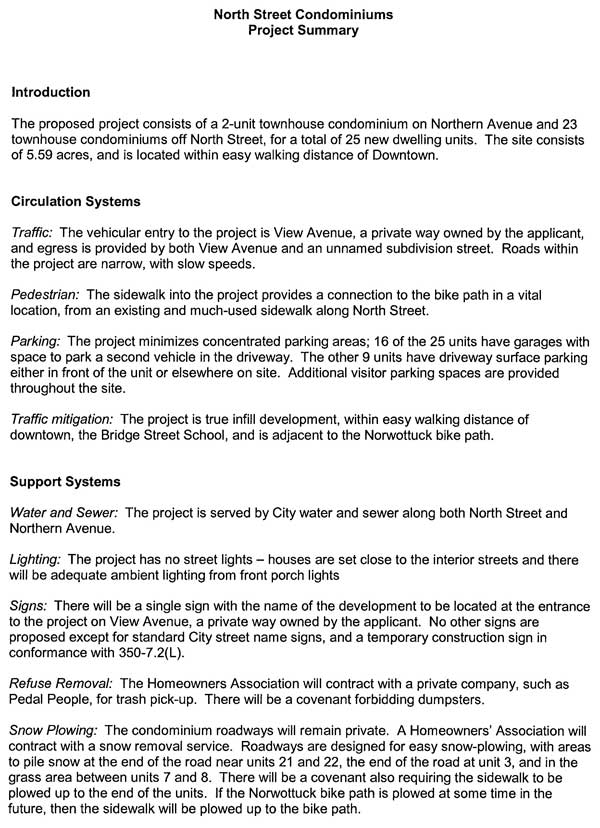
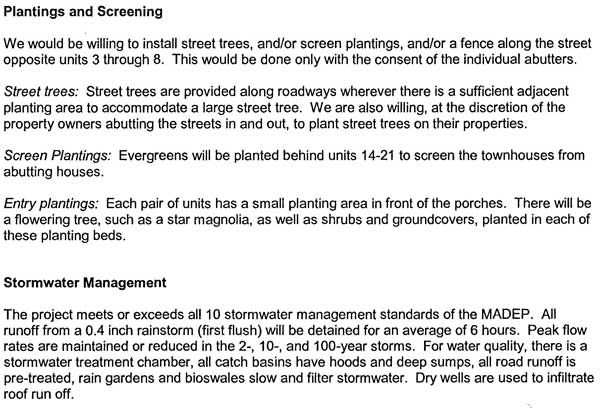
Two units at the end of Northern Avenue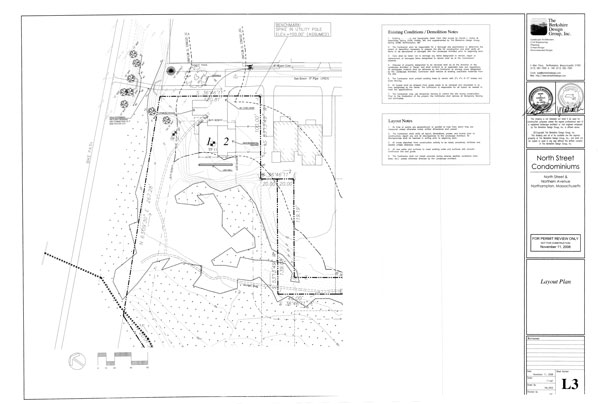
Detail
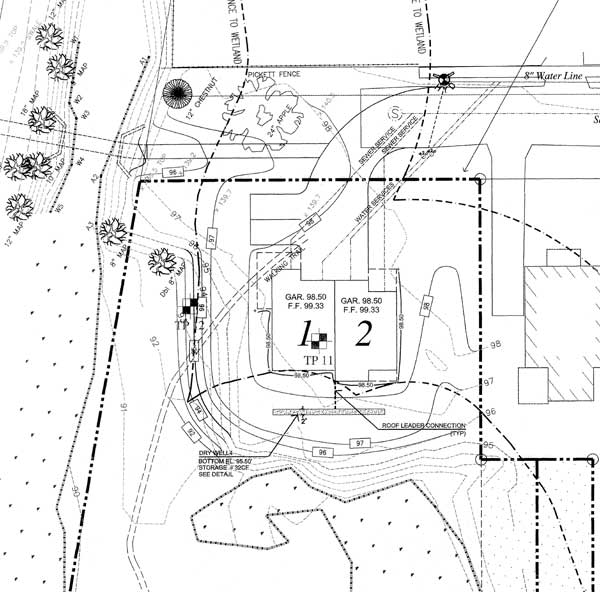
Main body of condos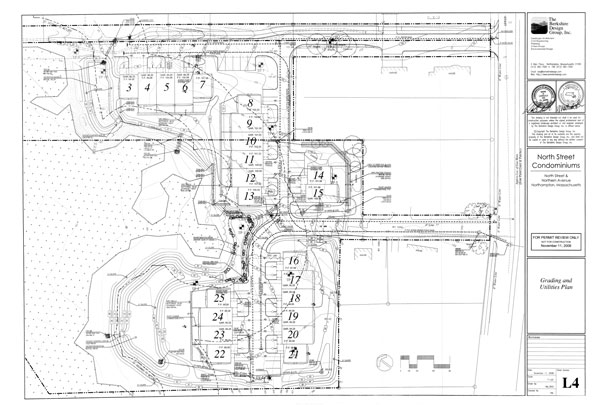
Detail
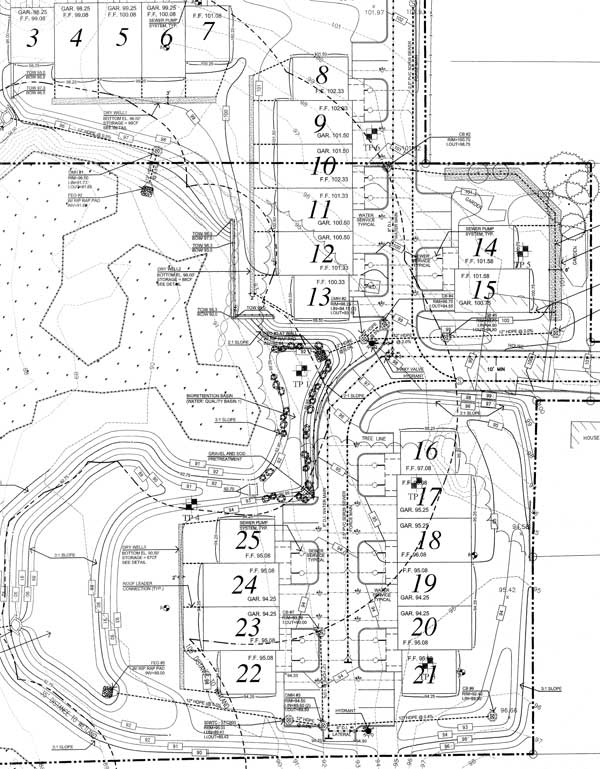
A close-up of where the main body of condos, roads and other disturbance encroach most closely on the wetlands around Millyard Brook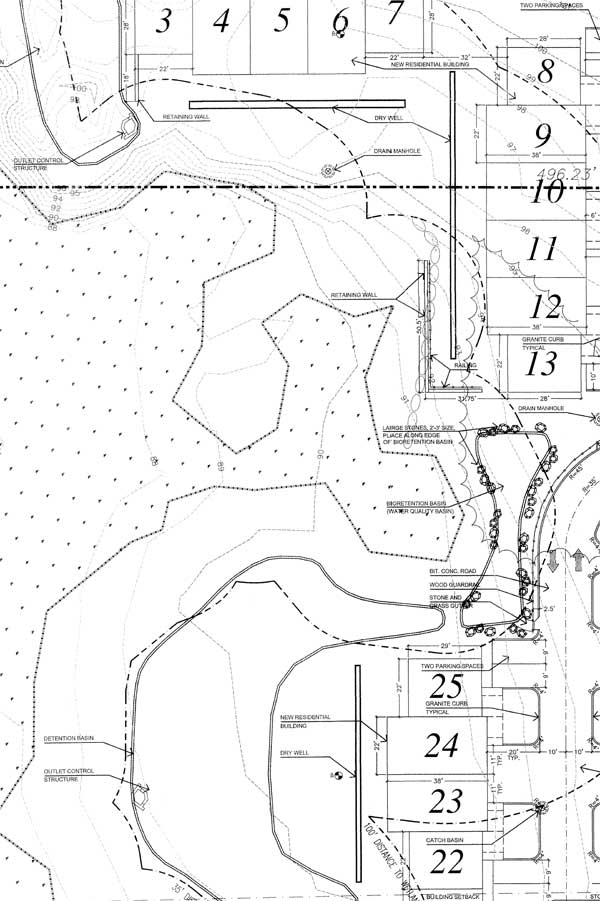
Download this PDF to view these and related plans at maximum detail.
See also:
Gazette: “Disputes hamper city condo project” (11/22/08)
Eight neighbors filed a lawsuit in Land Court in Boston last March over matters of title and rights-of-way. Some allege they own some of the View Avenue land and the unnamed street in question because they have been using it for years, according to the lawsuit.
“If he ever had a right-of-way, it was extinguished by adverse use,” said Brad A. Shimel, a Northampton attorney representing the plaintiffs.
The lawsuit, which is still active and won’t be heard for some time, asks the court to determine the rights of both the neighbors and the developer, and to order Kohl to hold off any construction until the matter is settled. Kohl said he would not begin construction until the Land Court issue is resolved.
Kirby on the Loose: “Condo project off North St. files for permits”
The final plans show that backyards, patios and walls will come within 12 feet of the bordered vegetative wetland. This will be the first so-called in-fill project to take advantage of the changes in our zoning in many commercially-oriented zoning districts. Permitted now is reducing the “no-encroachment zone” around wetlands from 35 feet to 10 feet.
Northampton’s
Flood and Natural Hazard Mitigation Plan: Floyd Flood Damage Reported
Behind View Avenue; Avoid Building on Filled Wetlands
In the map
below, the red flag behind View Avenue (the topmost flag) indicates a
flood damage report from Tropical Storm Floyd (1999). This area is in
the eastern portion of Kohl Construction’s proposed condo site, one of the more elevated portions. We infer that much of Kohl’s property may be at risk from heavy rainfall events.
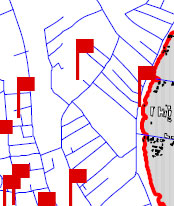
…In
general, a core problem for infill in Northampton is to avoid placing
large numbers of people and structures in low-lying areas downtown that
may be at risk for flooding. As the plan states, “In recent years,
heavy rainstorms have caused significant problems in more urbanized
areas as increased development inhibits proper drainage and existing or
poorly maintained water systems cannot handle increased stormwater
runoff…”
The plan specifically warns against building on Filled Wetlands:
Many areas of the City were developed before the passage of
the Massachusetts Wetlands Protection Act of 1972. Historically filled
wetlands are commonly related to problems with wet basements, flooding,
shifting foundations and failed septic systems. Development in
historically filled wetlands should be discouraged through zoning in
order to protect health and safety. (p.24)
It is well known that some of Kohl’s land contains fill from work on Market Street, dumped there in the early 1980s. Kohl’s own Request for Determination of Applicability
notes, “The wetlands are degraded with masonry and other construction
and road building debris.” It seems plausible that parts of Kohl’s
property meet the definition of a filled wetland.
Smart Growth vs. “Smart Growth”
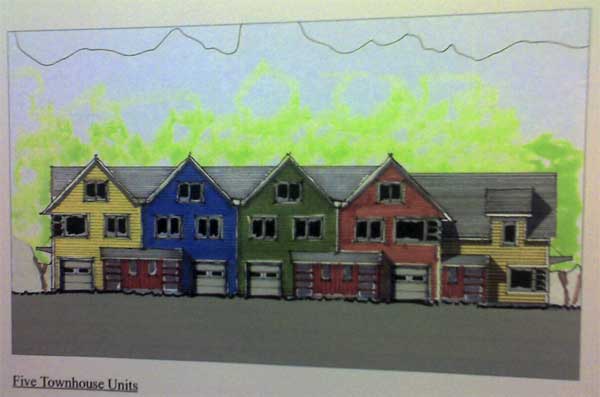
The problems with Kohl’s condo proposal include:
- It threatens green infrastructure by putting roads and structures as close as 35 feet or less to a wetland. Scientific evidence
indicates that substantial disturbance within 50 feet puts wetland
ecology at risk and threatens water quality. In addition, the condos
themselves appear to be at risk of flooding. - It goes against the existing character and diversity of housing stock in the neighborhood by offering a monotonous, cookie-cutter design scheme with little sense of place.
- As Daryl LaFleur
observes, “the Kohl North Street area development proposal includes row
house condominiums set to the rear of parking lots, not free standing
detached single family homes that front the ‘street’, which would
better match the existing neighborhood and is also a tenet of Smart
Growth.”
Smart Growth is most palatable when it’s
implemented as a whole. When public and private actors are allowed to
cherry pick aspects that suit their convenience, the “Smart” can be
lost.
Condo Monotony: The Future of Ward 3?
To maximize profits, the developers have shoehorned units into their
lots with little regard to the preexisting appearance of their
neighborhoods. The developments feel inward-facing or ‘withdrawn’, not
part of the regular street fabric. These aspects are probably what
prompted the “carbuncle” comment from the planning board member.
New Hazards Mitigation Plan Reflects Weakened Protection for Wetlands
Unfortunately, the City Council voted 7-2 in 2007 to permit development in multiple districts to encroach as close as 10 feet to wetlands. In a rapid shift of priorities, facilitating urban infill was now deemed more important than flood mitigation, water pollution control, or urban greenspace. The proposed condo development off North Street is a good example of a project that relies on the narrowed buffer zones…
The claim that allowing development within 50 feet of wetlands can
still give effective protection does not bear up under scientific
scrutiny. As Hyla Ecological Services noted in 2007:
“Buffers of less than 50 feet in width are generally
ineffective in protecting wetlands. Buffers larger than 50 feet are
necessary to protect wetlands from an influx of sediment and nutrients,
to protect wetlands from direct human disturbance, to protect sensitive
wildlife species from adverse impacts, and to protect wetlands from the
adverse effects of changes in quantity of water entering the
wetland…” (Castelle et al., ‘Wetland Buffers: Use and Effectiveness’,
1992)“Buffer function was found to be directly related to the
width of the buffer. Ninety-five percent of buffers smaller than 50
feet suffered a direct human impact within the buffer, while only 35%
of buffers wider than 50 feet suffered direct human impact. Human
impacts to the buffer zone resulted in increased impact on the wetland
by noise, physical disturbance of foraging and nesting areas, and
dumping refuse and yard waste. Overall, large buffers reduced the
degree of changes in water quality, sediment load, and the quantity of
water entering the adjacent wetland.” (Castelle et al., 1992)
…Most striking in the [Environmental Law Institute] report is that some locales desire wider
buffers in areas of intense land use to address the higher levels of
pollution and runoff. By contrast, Northampton has its narrowest
buffers in these areas.
Earlier this year, NSNA engaged Hyla to
compare Northampton’s new Wetlands Ordinance to the regulations in
other cities across Massachusetts. Hyla found that Northampton is now an outlier. In the entire state, it’s hard to find anything similar to our 10-foot buffer zones for new development…
“…it is forecasted that, Massachusetts,
and the rest of New England, is long overdue for a major hurricane to
make landfall. Based on past hurricane and tropical storm landfalls,
the frequency of tropical systems to hit the Massachusetts coastline is
an average of once out of every six years.” (Hazards Mitigation Plan, p.28)
Gazette guest column: “Don’t ease controls on wetlands” (10/25/07, emphasis added)
[Alexandra Dawson, chair of Hadley’s Conservation Commission,
writes,] …Northampton has adopted changes to its bylaws that limit
the setback between development and wetlands in the business district
to 10 feet, although it is obvious that 10 feet is not even enough
space to accommodate the big yellow machines that do the building. It
is true that a recent court decision indicates that wetlands ordinances
(or conservation commission regulations adopted under them) should
enumerate setbacks so that builders need not guess what will be
required of them. Unfortunately, there is also case law stating
that whatever is so established limits the commission’s discretion to
ask for more unless there is a specific showing of why one proposal
stands out from the others. If the setback in the ordinance is 10 feet,
it will be very hard for the commission to justify a permit restricting
building for 50 feet. For this reason, most eastern Massachusetts bylaws that contain setbacks start at 25 to 50 feet.
Mike Kirby: “The Meadowbrook Chronicles Part One”
The
Meadowbrook story has many important facets. Of particular interest to
us are the consequences that can follow from building homes near
wetlands…
The developers built 255 units of affordable
apartments there. They crammed them in everywhere they could, pushing
them up into the bluffs, and close to the creek and wetlands. No
backyards to speak of. One third of the buildings were built within 50
feet of the wetlands, 63% of the buildings are within the customary 100
feet of wetlands.
None of the buildings have cellars under their
apartments. If they have cellars, there are people living in them. The
cellar floors in the basement apartments in Buildings #4 and #2 are
lower than the surrounding swamp. Some slabs have cracks in them.
People have been flooded out. No moisture-proof barriers between the
surrounding earth and the foundations. Moisture and mold percolate up
into people’s apartments via the chases that hold utilities. If you
wonder why low-income children are afflicted with a whole host of
respiratory diseases, you have to look no further than the children of
the floor level and basement apartments of Meadowbrook…
Northampton
Redoubt: Doug Kohl reduces “footprint” of subdivision proposal due to
the discovery of vernal pools in the North Street area wetlands (9/12/07)
Daryl LaFleur writes:
When
I asked about the possibility of basements flooding in the future due
to their proximity to the wetlands he indicated that some of the units
would have basements provided they can be “drained to daylight.” Others
would be constructed on concrete slabs. He also noted that most of the
units would have one garage bay located within the perimeter of the
buildings on the first floor, reducing the need for surface parking by
one space for each of these units. It remains unclear to me how large
construction equipment can operate very close to wetlands without
harming them. It appears some of the units would be located within
twenty feet of the wetlands.
Gazette: “Council adopts wetlands ordinance”
At-large
City Councilor James M. Dostal proposed an amendment Thursday that
called for increasing the 10 feet no-encroachment zones in urban
residential districts to 50 feet because of serious concerns about
homes flooding, saying “We shouldn’t be building there…”
Adam
Cohen, of North Street and an organizer of the North Street
Neighborhood Association said he believes a 50-foot no-[en]croachment
zone would be better for the city’s urban residential districts. That,
he said, represents “consumer protection for homeowners.”
Gazette: “Region’s storms going to extremes, report finds” (12/5/08)
Today’s Gazette
reports New England is experiencing more extreme rainstorms than in the
past. We can also expect longer periods of relative dryness.
Extreme downpours and snowstorms are rising in frequency nationally, with the highest increases in New England…
Massachusetts saw a 67 percent rise in severe storms during [1948-2006], trailing only Rhode Island and New Hampshire…
…the top 10 severe storms in the state all occurred in the past decade…
…scientists expect that extreme downpours will punctuate longer periods of relative dryness, increasing the risk of drought…
Wetlands
can moderate both flooding and drought, absorbing excess water during
storms and releasing it slowly during periods of dryness. Today’s
report underscores the value of our remaining wetlands in Northampton.
EPA: Wetlands and Flood Protection
Wetlands
within and downstream of urban areas are particularly valuable,
counteracting the greatly increased rate and volume of surface-water
runoff from pavement and buildings…
Northampton Redoubt: Urban Planning, Public Policies, and Urban Ecology
…the Kohl development on North Street will probably not closely mimic
dense older urban neighborhoods in any country, and it will cost us
part of an urban forest as well. Look at the schematic below and tell
me that this proposed development is the best that can be done with
regards to Smart Growth. It appears to me as a tightly clustered
residential sprawl-development moved into town with basically a token
nod toward Smart Growth principles, that is it’s close to town and it’s
clustered…
…I have not been able to find definitions of
infill that include removing viable greenfields, though they may exist.
Generally infill seems to concern redeveloping previously developed
areas, vacant lots, or brownfields and rehabilitating historic
buildings. Thus obscured from the recent debate has been the importance
of maintaining Northampton’s Urban Ecology, which enhances the quality
of life of intown dwellers, human or otherwise…
Topographical Map Shows How Kohl Condo Proposal Will Eat Into a Rare Stand of Mature Trees in Downtown
The
following view dramatizes the considerable amount of impervious surface
already in the area, especially around King Street and the Coca-Cola
plant. Kohl’s “infill” project will convert a significant amount of the
remaining greenspace to impervious surface. The presence of Millyard Brook shows that this area serves as a natural sink for water in the neighborhood.
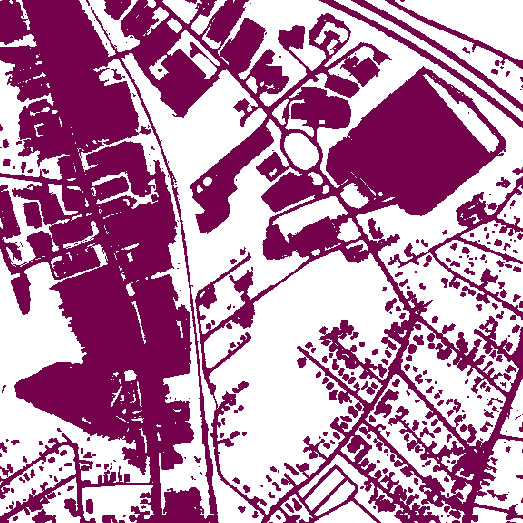
Alex Ghiselin, Letter to Gazette: “Don’t let development encroach on our wetlands”
The
failure of the storm water system built as a part of the Northampton
High School renovation six years ago illustrates why protecting
wetlands is so important. Silt has filled the retention pond so there
is no capacity to slow a storm surge which now flows unimpeded into the
Mill River and contributes to flooding downstream. This accumulated
silt also raised the water table and spills ground water into nearby
basements…
Without maintenance, these [storm water mitigation] systems are part of the problem, not the solution…
Wetlands do not need to be maintained; they just need to be protected.
Carlon Drive: Compensatory Wetland Not Working
Mike Kirby writes:
In
Carlon Drive, they simply scooped out a hole in the swamp-bottom, and
called it a detention structure. Today it is just a pond, and a
stagnant smelly one. It was designed to have a dry forebay, and a
shallow main chamber was supposed to have only about 6 inches of water
in it. This was supposed to be a compensatory wetland, full of cattails
and wildflowers. A rock check dam was supposed to hold back the “first
flush” off the parking lots and trap pollutants, and outflow from it
was supposed to feed the wet part of the detention pond. Here rain
water pouring off the new parking areas and street was supposed to be
stored, and discharged safely.
That was the plan. Today if you
stand by the pond and look down into it, you’ll see the check dam is
now about two feet underwater. You can’t even see where they planted
the marshgrass and flowers. The area is under water. Even in a fairly
dry summer, the detention pond is only about a foot and a half from the
top of the bank. There’s no storage to speak of, no discharge, no
filtering. As it is constructed now, grey water from the parking lots
and the access street goes directly into the swamp and the Connecticut
River.
Paved Surfaces, Salt and Water Bodies: A Bad Mix
Snow and Slush Expose Limits of Storm Drains
Easthampton Flooding Hazard: Snow-Clogged Storm Drains
Photos Show: Man-Made Lakes and Stormwater Retention Systems
Are No Substitute for Natural Wetlands
EPA: “Mosquito proliferation in stormwater ponds is a concern”
Anyone who has walked around the wetlands between North Street and the bike trail can attest to its large numbers of mosquitoes in the warmer months…
“Mosquito proliferation in stormwater ponds is a concern,
especially when so many wet and dry ponds are in place and continue to
be installed across the country. Many ponds are not properly
maintained, particularly in cases where they are installed in
subdivisions and other developments where the entity responsible for
long-term maintenance is not clearly defined once the construction is
complete…” [EPA, emphasis added]
Detention Pools, Children and Drowning
Northampton Residents Sue Developer Douglas Kohl to Resolve Questions
of Title and Rights-of-Way (3/13/08)
The lawsuit names two companies affiliated with local developer Douglas
Kohl and raises questions about ownership of the land which go back
over 90 years. The lawsuit states the original owners never transferred
title to a portion of the land. The disputed land seems to have been
intended to become streets serving now outdated building lots. No such
streets were ever built.
The developer now wants to use the
alleged street to access the condominium project. The neighbors claim
that any intent to create streets was abandoned long ago. Certain
neighbors also allege they have been using portions of the land as
their own for many years and that they have acquired legal rights to
those portions of the land. One property owner previously won a similar
case in the Hampshire Probate Court on that basis and acquired
ownership to part of the alleged street.
State Offers Funds to Help Conserve North Street Woods
Here is the relevant portion of “An Act Providing for the Preservation and Improvement of Land, Parks, and Clean Energy in the Commonwealth”, as signed by Governor Deval Patrick on August 14:
2000-7015… that not less than $100,000
be expended for the acquisition of wooded land to be used for
conservation and passive recreation in the North Street neighborhood of
the city of Northampton, provided that the abutters of said property
provide matching funds for said acquisition…